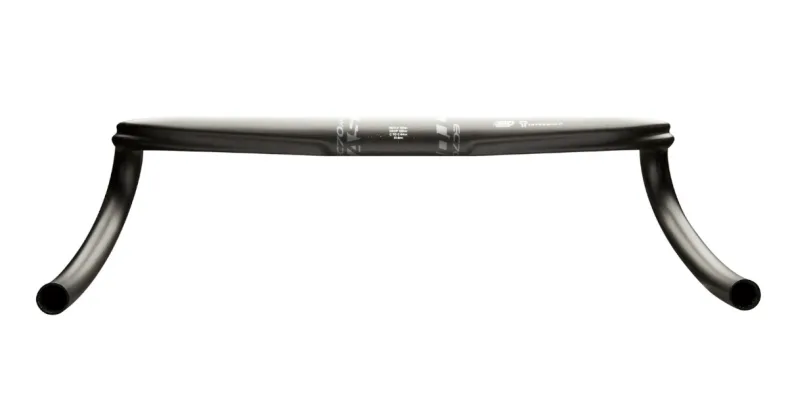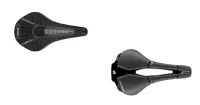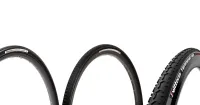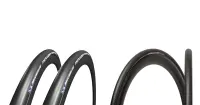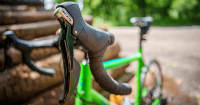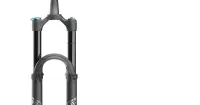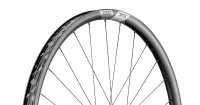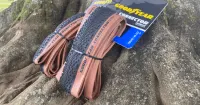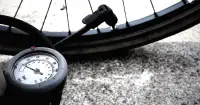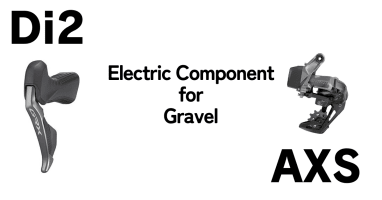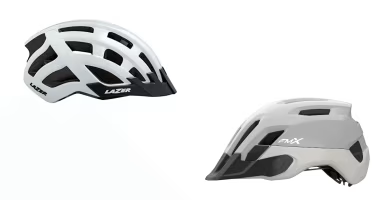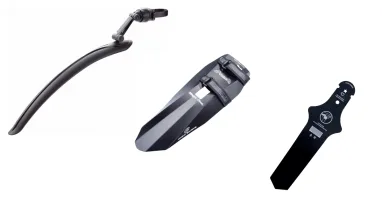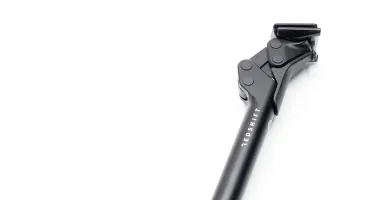Language Menu
- 日本語
- English
Why so popular on gravel bikes? Advantages and disadvantages of flared handles and how to choose
Flared handlebars are being increasingly adopted on gravel bikes. We will look at what flared handlebars are and why they are so popular, starting with their advantages and disadvantages.
Modified at: 2023.10.26Posted at: 2022.9.27
Table Of Contents
- What is a flared handle?
- Advantages of flared handlebars
- Increased stability in bike and handlebar operation
- Can carry a lot of luggage
- Disadvantages of flared handles.
- Fewer types
- Easier to hit obstacles
- How to choose a flared handle
- Pay attention to the size!
- Be aware that STI levers may tilt.
- Shallow drop is better for aggressive roads.
What is a flared handle?
A flared handle is a type of drop handle for road and gravel bikes in which the drop portion of the handle is wider across than the flat portion.

MTBs used on rough roads are usually fitted with wide handlebars, while road bikes, which take an aerodynamic position, usually have handlebar widths as narrow as possible to reduce aerodynamic drag.
Flared handlebars incorporate both of these features: in the bracket position, the body is folded down to reduce aerodynamic drag, and on rough roads, the lower handlebars are held in a wider position to improve bike control and stability.
Depending on the product, flared handlebars often widen the distance between the lower handlebars by 10 cm relative to the distance between the bracket positions, transforming a 400 mm handlebar into a 500 mm wide handlebar at the lower handlebar.
A normal drop handlebar drops vertically from the bracket position, but a flared handlebar drops outward, so you can tell if it is a flared handlebar by looking at the handlebar shape from the front and rear.
Advantages of flared handlebars
Increased stability in bike and handlebar operation
The biggest advantage of flared handlebars is that the wider lower handlebar position increases stability on gravel and other rough terrain.
Unlike on the road, which is often ridden in a straight line, sharp turns, such as 180-degree turns, are common on trails such as MTB trails. At such points, the wider the handlebars, the easier it is to maneuver.
Also, on rough roads, where there are many bumps and bumps from the road surface, it is normal to open the arms and use the body like a suspension, but this is not possible with normal drop handlebars. With flared handlebars, the lower handlebars are wider, allowing for both of these uses.
Of course, it is still narrower than “super wide flat handlebars” such as 800mm for MTB, but the maximum width of road bike handlebars is 460mm at the widest, so if you want to go wider than that, you will inevitably choose flared handlebars.
Can carry a lot of luggage
One of the most fun ways to enjoy gravel bikes is bicycle camping and bicycle touring.
When you go bicycle camping or bicycle touring, there are many things to load, such as camping equipment and a change of clothes, and it is important how much you can load not only in the saddlebags and frame bags, but also in the handlebar bags.
The maximum width of a standard road bike handlebar is 460mm, but with flared handlebars, the area where the handlebar bag is attached is more than 500mm, so there is plenty of room for the handlebar bag to fit.
Especially, handlebags with a large capacity, such as those used for bike camping, are designed to be wider than the width of a flat-bar handlebar, which is not wide enough for a road bike handlebar.
Flared handlebars solve this problem.
Disadvantages of flared handles.
Fewer types
Flared handlebars are a type of drop handlebar that has become popular in the past few years, so one of the disadvantages is that there are still few types of products.
Since the popularity of gravel bikes is rapidly increasing worldwide and in the industry, there is a possibility that the number of flared handlebars will increase in the future, but at present there are only a few types, and the choices in price, material, and shape are limited.
Easier to hit obstacles
With normal drop handlebars, the maximum width is only about the rider’s shoulder width, so it is unlikely that the handlebars will come into contact with obstacles on the road while riding.
However, with flared handlebars, the lower handlebars are wider than the rider’s shoulder width, so if the rider slides through the handlebars as if riding a road bike, there is a greater chance of hitting a tree, guardrail, or other obstacle. If the other party is a person, it will lead to an accident against the person, so care should be taken.
How to choose a flared handle
Pay attention to the size!
Road bike handlebars are sized by the distance of the lower handlebar portion, which is determined in two ways: C-C (center-to-center: distance from the center of the bar end to the center of the handlebar) and outer-to-outer (outer-to-outer distance from the outer bar end to the outer bar end).
For normal drop handlebars that are vertically down, you can just look at the specs as indicated, but for flared handlebars, the bracket portion and the lower handle portion are open, so the handlebar size will be completely different depending on whether the size indication is for the bracket portion or the end portion.
For example, ZIPP gravel handlebars are sized C-C on the specs, but ZIPP officially states that "C-C is the distance between the bracket portions, not the distance between the drop end portions.

This area varies from manufacturer to manufacturer, so be careful when choosing.
Be aware that STI levers may tilt.
This also varies from product to product, but the curve may start from the bracket part because the drop part is spread out in the shape of a “C”.
In this case, the STI lever will be tilted together, which not only makes it difficult to brake and shift gears, but also makes it easier to hurt your hand because you will have to twist your wrist when you grip the bracket.
Some may say, “It doesn’t matter if it’s at an angle,” but for some people it just doesn’t fit their bodies. Some products are vertical up to the bracket and flare out from below it, so be sure to choose such a product.
Shallow drop is better for aggressive roads.
Drop handlebars vary in how far down they curve from the bracket depending on the product. If you are gripping the flared portion for more control on gravel, a regular larger drop will give you too deep a forward lean, and you risk losing your balance and falling forward.
If you are using the drop portion for power on paved roads, this is not a problem, but if you plan to use it on rough roads, it is recommended that you choose a product with a smaller drop.
Gravel Bike Position Guide
Gravel bikes have a slightly different approach to position than both road bikes and MTBs. This section explains how to optimize the position.
How to choose and use a dropper seatpost for gravel bikes
Dropper seatposts are increasingly being used on gravel bikes. The following is a summary of how to select a seat post unique to gravel bikes and what to look out for when choosing one.
How should you decide on a position for a gravel bike, which is intended to be between a road bike and a MTB?
How to choose a handlebar for a gravel bike
Gravel bikes look almost the same as road bikes, but their purpose is somewhat different. The following is a summary of how to select handlebars, which are important for the operation and position of the bike.
Which wheel is better for a gravel bike, 700C or 650B?
When choosing gravel bike wheels, a common concern is whether to go with 700C or 650B. 700C or 650B is better, and we summarize the advantages and disadvantages of both, as well as how to choose.
Current Article
Why so popular on gravel bikes? Advantages and disadvantages of flared handles and how to choose
Flared handlebars are being increasingly adopted on gravel bikes. We will look at what flared handlebars are and why they are so popular, starting with their advantages and disadvantages.
How to choose the right saddle for your gravel bike!
Although not well known, many saddles optimized for gravel bikes have been introduced in the past few years. This section describes the characteristics of gravel bike saddles and how to choose the right saddle for you.
Easily convert your bicycle to gravel bike
Gravel bikes are often bought from manufacturers who sell them as "gravel bikes," but it is also possible to customize a road bike or cross bike and "gravel bike-ize" it.
How to convert a hybrid bike into a gravel bike
Hybrid bikes and gravel bikes are similar in concept. Hybrid bikes can be converted to gravel with little replacement cost, depending on the component parts.
Choosing Gravel Tires for Road Bikes
Even if your road bike is mainly used for riding on paved roads, you can enjoy gravel riding by installing gravel tires. In this issue, we have compiled a list of gravel tire selection and precautions for road bikes.
Which type is best? Get to know the different types of gravel tires.
Gravel tires are in between the properties of road tires and MTB tires, and there is a lineup of tires with both properties. In this issue, we will introduce the different types of gravel tires and how to choose and customize them for different uses.
Is tubeless the best? Which type of gravel tire is best?
Tire selection is one of the most enjoyable and difficult aspects of gravel bike customization. In this article, we will look at the differences between tire types and the types of tires to choose for your gravel bike, along with their advantages and disadvantages.
How to choose a handlebar for a gravel bike
Gravel bikes look almost the same as road bikes, but their purpose is somewhat different. The following is a summary of how to select handlebars, which are important for the operation and position of the bike.
How to Choose Sprockets for Gravel Bikes
Among the customizations for gravel bikes, one of the easiest even for beginners to do and with relatively little impact on the ride is to change the sprocket. In this article, we have compiled a list of sprocket selection methods unique to gravel bikes.
How to choose gravel tires for those who just want to go fast
Gravel bikes are said to be slower than road bikes. If you want to go faster on a gravel bike! If you want to go faster on a gravel road bike, you can make it lighter and faster by simply customizing the tires.
Optimizing handlebar position on gravel road bikes
The handlebar position of a gravel bike is similar to that of a road bike but somewhat different. The following is a summary of the concept of handlebar position and how to achieve the optimal handlebar position.
Current Article
Why so popular on gravel bikes? Advantages and disadvantages of flared handles and how to choose
Flared handlebars are being increasingly adopted on gravel bikes. We will look at what flared handlebars are and why they are so popular, starting with their advantages and disadvantages.
Customization for comfort on rough roads
Gravel bikes on gravel roads, for example, are subject to more vibration and shock from the road surface than those on paved roads. Optimizing for rough roads can make riding more comfortable.
Advantages and disadvantages of suspension and seat post on gravel bikes
When riding a gravel bike over rough terrain like MTB, you want suspension. An easy way to add suspension to your gravel bike is with a suspension seatpost.
How to add suspension to a gravel bike
Gravel bikes can be ridden on unpaved roads, but the basic standard is a "rigid fork" without suspension. In this article, we summarize how to add suspension to a gravel bike without suspension.
How should you decide on a position for a gravel bike, which is intended to be between a road bike and a MTB?
Current Article
Why so popular on gravel bikes? Advantages and disadvantages of flared handles and how to choose
Flared handlebars are being increasingly adopted on gravel bikes. We will look at what flared handlebars are and why they are so popular, starting with their advantages and disadvantages.
How to customize a gravel bike with MTB wheels and how to choose
Gravel bikes can also enjoy MTB-like riding with fat tires. If you are going to enjoy riding on rough roads, one way to have fun is to customize it with MTB wheels to make it more MTB-like.
The Perfect Guide to Choosing Gravel Tires
One of the most fun and most affordable customizations for gravel bikes is changing tires. However, gravel bikes, by their very nature, are also the most difficult to choose tires for. In this article, we will thoroughly explain how best to choose tires for gravel bikes.
Is tubeless the best? Which type of gravel tire is best?
Tire selection is one of the most enjoyable and difficult aspects of gravel bike customization. In this article, we will look at the differences between tire types and the types of tires to choose for your gravel bike, along with their advantages and disadvantages.
Ride more comfort! Ride gravel bike with proper air pressure!
There is a "proper air pressure" for bicycle tires. This section summarizes what the correct air pressure is, how to check it and how to get the correct air pressure, and the changes in riding that can be achieved by changing the air pressure.
What kind of road is gravel? The kind of riding a gravel bike is designed to do
What kind of "gravel" roads can gravel bikes be ridden on? We have compiled a definition and a summary of how the manufacturer expects you to ride it, and how it is not expected to be ridden.
